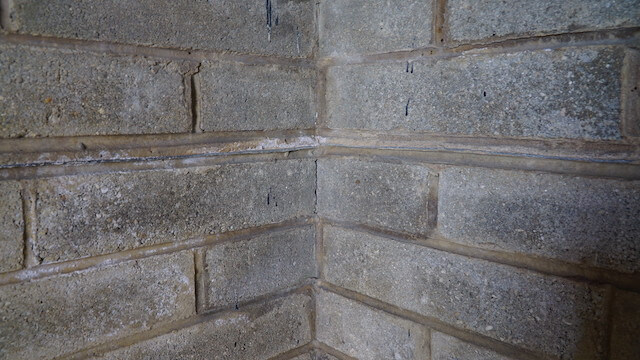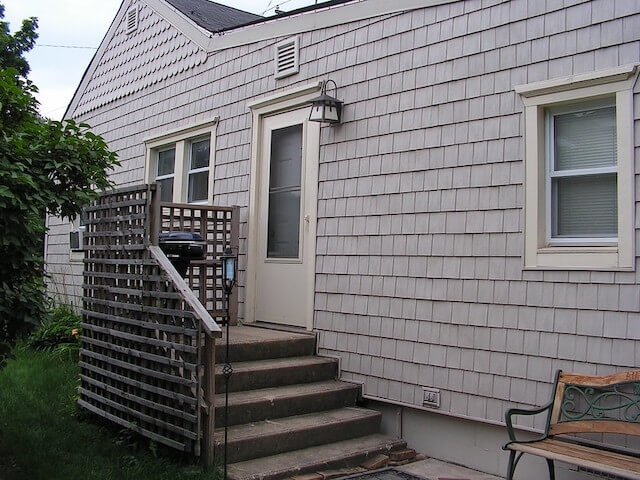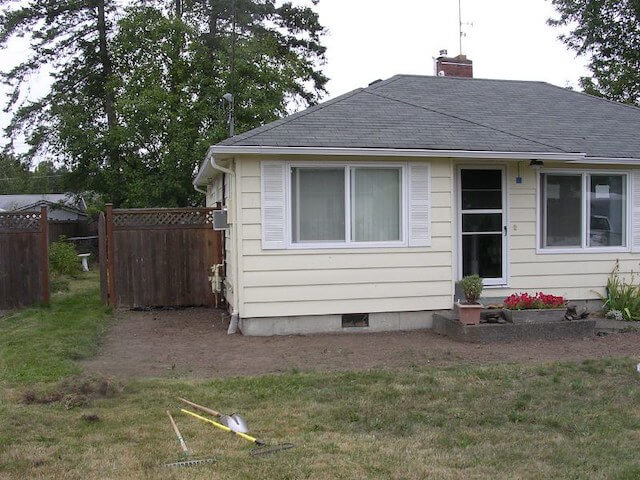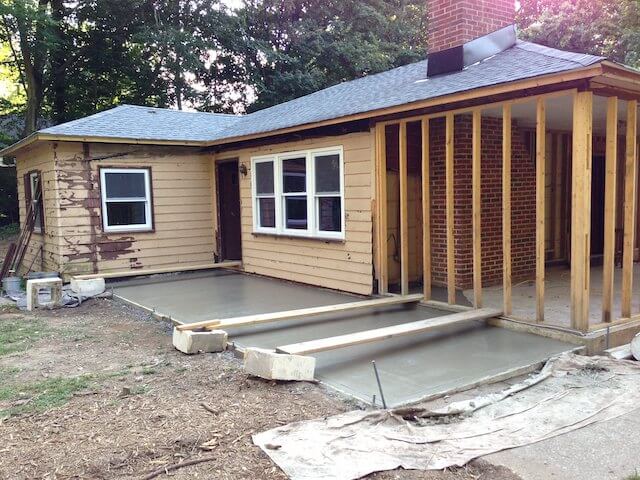The Damp Proof Course, or DPC, is an indispensable part of house construction.
This part of the house is commonly laid on the basement level to prevent moisture and water from damaging the floors or walls.
I have received numerous questions about the height of the patio compared to the Damp Proof Course.
So, how should the paving be constructed against the DPC to achieve the best protection and aesthetical look?
Can the patio be level with DPC? I will answer all your questions in the following sections. Keep reading to find out!
Table of Contents
Can The Patio Be Level With DPC?
No. There must be a reasonable gap between the Damp Proof Course and the patio so that water can drain effectively without damaging your construction.
In house construction, the ground level must be at least 150mm higher than the ground level or patio, according to the building rules of England and Wales.
This 150+ mm gap helps reduce the risk of splashback effect when it rains.
It ensures that the water piling up from heavy storms and rains cannot reach the elevated DPC level, making the hosepipe run unchecked.

Know About The Damp Proof Course
For many drainage and patio constructions, identifying an exact level of the Damp Proof Course is crucial. It helps you establish the patio correctly and avoid serious construction miscalculations.
The process is not as straightforward as people think. You have to investigate to spot the correct position on many housing properties.
Here are a few methods to identify the distance between your patio and DPC.
On most housing properties, the gap between DPC and the patio should be from 100 mm minimum to 450 mm maximum above the patio or ground level. In addition, the brick type or appearance is different at the DPC.
Though the standard is 150 mm, the patio can be much lower than 150 mm below the DPC level and vice versa. The gap can also change if the patio slopes along the building’s length.

Bending The Rules
The 150 mm gap between the patio or ground level and the Damp proof course is a standard or “best practice.”
In real life, there’re many situations where it’s impossible to construct this 150 mm gap and follow the regulation.
This 150 mm regulation should always be ensured for large buildings and new construction projects.
However, following this rule and ensuring the gap may take tremendous effort for small housing construction or patio building.
Therefore, you can still “bend” this rule as long as it meets these requirements:
- Except for private properties, the rule-bending is not legit and should not be applied to any commercial or public properties.
- This rule breaching must be approved with the construction’s owner’s agreement.
- Though the gap can be minimized, it cannot be less than 75 mm. If the patio level is less than 75 mm below DPC, it leads to serious construction and hazards.
Steps And Ramps
You must also take the construction steps and ramps into account when constructing the patio and DPC level. They can be installed to be “flush” with the house’s internal floors, creating a “threshold level.”
This practice is applicable when the DPC level is not “bridged.” If you decide to construct the patio less than 150 mm below DPC, it only extends over a minimum part of the brickwork.

Things to Remember When Laying A Patio With DPC
Here are some solutions if the patio level is too high and you want the DPC to be less than 150mm above it.
The Standard Arrangement
According to the standard arrangement, you need to keep the paving level at 150 mm minimum below DPC.
The patio must also slope away, starting from the wall at a 1:60 slope ratio.
If the patio is somewhat difficult for water drainage (take the riven flag, for example), you can increase this slope ratio to 1:40.
If the patio can drain water well (plain concrete or blocks), reduce the slope ratio accordingly.
The Arrangement For Dry Area
This is a more efficient solution to workaround the undesired distance between the paving level and the DPC.
You can create a channel stretching along the walls with its base standing at 150 mm below the DPC level.
The channel’s base can be made of concrete, and it should slope away from the wall at a 1:40 ratio minimum. Meanwhile, you can use a curb to construct the channel retainer edge.
This channel’s function is to direct and evacuate the water to the nearby outfall point (like a gully).
In this way, you can still breach the 150 mm rule without compromising the drainage capacity of your patio.
Using Drained Channels
Another solution to deal with high paving levels is installing drained channels. This is the best method when the liter accumulation cannot go on properly.
You can install a drainage pipe made of perforated plastic on the channel’s base and connect it to the SW drainage pipes.
Ensure that it is connected at a convenient point lower than the DPC level.
Also, that point should be covered in clean gravel. You can also construct a drainage tank or composite to protect the walling.
This resolution brings along some minor risks, and it should be the last resort in difficult cases.

How To Install A Patio Level On Top Of DPC And Drain Water Properly?
So, how to install a patio while breaching the 150 mm rule and still achieve proper water drainage?
There are two main methods depending on the construction’s conditions.
Step 1: How To Drain off The Water On The Patio Without Bridging The DPC.
If you cannot drain the water towards the neighbor’s lands, the only solution is to drain water towards your house.
Of course, there needs to be proper drainage that prevents water from piling up against the walls above the DPC level.
Step 2: Find Another Place To Get Rid Of The Water After Draining It Off The Patio
A soakaway or French drain doesn’t seem like an ideal solution since they are very costly and require various efforts and machinery to construct.
A more efficient solution would be using a surface water drain in the area.
You can take advantage of the blank space in the corner between the two walls and install the linear channel drains.
If there isn’t any blank space to use, you can go back to the French drain or soakaway solutions.

FAQs
Here are some additional information and tips you should not miss when constructing a house patio. If you have some queries about patio construction, check out the sections below.
Should The Patio Be Level Or Sloped?
The patio should be sloped away from the wall, not level with the DPC.
The leaning rate must be around 3mm (⅛ inches) for each running foot and reach between 50mm (2 inches) and 100mm (4 inches) above ground.
Should I Leave A Gap Between The Patio And The House?
The answer is yes. You need to create a long gap between the house and the patio so that water can be drained.
Without that gap, the water cannot drain, and it will form a pooling, damaging the house’s floors and weakening the mortars.
How Far Below The Damp Course Should Paving Be?
As mentioned above, the paving or patio construction should be at least 100 mm to 150 mm below the Damp Proof Course.
If the distance is not high enough, the water cannot evacuate and can damage your walls or floors.
What Should I Put Between The Patio And The House?
The space between your patio and the house should be filled with seams or seal joints. These caulking materials can resist and evacuate water efficiently, preventing it from damaging your house’s construction.
Don’t use concrete since it’s too flexible and can wear down in the long run. Another choice is polymeric sand or rubber stripping.
How Do You Repair An Uneven Concrete Patio?
Fixing a cracking or uneven concrete patio requires straightforward methods. The quickest way is to resurface the top, but it only hides the problem without fixing it.
A more efficient and beneficial fixing method, in the long run, is veneering the patio. You will use a mortar to apply an additional concrete layer on your patio and achieve a smooth, balanced surface.
Final Thoughts
In summary, you cannot lay the patio level with the DPC. There should be a gap between the two constructions of at least 100mm or 150mm.
It will allow the water to evacuate and not damage your house’s floors and walls.
I hope the answer provided can help you design your house better and avoid setting up false construction. If you have any further questions, don’t hesitate to comment and let me know. Thank you for your time!

